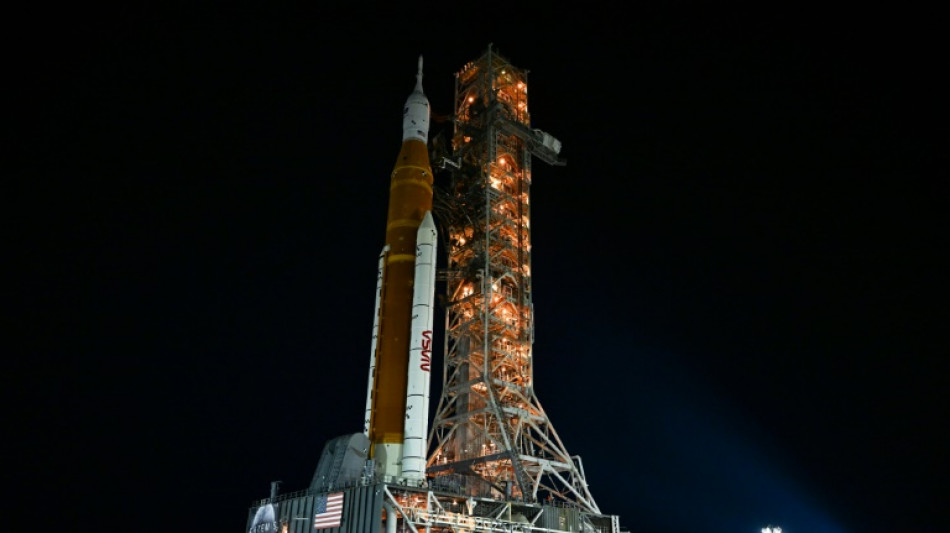
-
 Italy working hard to prevent extra US tariffs on pasta
Italy working hard to prevent extra US tariffs on pasta
-
Sinner out of Shanghai Masters as Djokovic battles into last 16
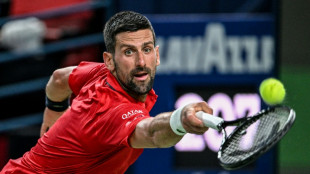
-
 Swift rules N. America box office with 'Showgirl' event
Swift rules N. America box office with 'Showgirl' event
-
Ryder Cup hero MacIntyre wins Alfred Dunhill Links on home soil

-
 Republicans warn of pain ahead as US shutdown faces second week
Republicans warn of pain ahead as US shutdown faces second week
-
Sevilla rout champions Barca in shock Liga thrashing

-
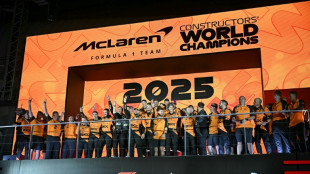 Norris-Piastri clash overshadows McLaren constructors' title win
Norris-Piastri clash overshadows McLaren constructors' title win
-
Trump administration declares US cities war zones

-
 Bad Bunny takes aim at Super Bowl backlash in 'SNL' host gig
Bad Bunny takes aim at Super Bowl backlash in 'SNL' host gig
-
El Khannouss fires Stuttgart into Bundesliga top four

-
 Insatiable Pogacar romps to European title
Insatiable Pogacar romps to European title
-
Newcastle inflict more pain on Postecoglou, Everton end Palace's unbeaten run

-
 Daryz wins Prix de l'Arc de Triomphe thriller
Daryz wins Prix de l'Arc de Triomphe thriller
-
Russell wins Singapore GP as McLaren seal constructors' title

-
 Landslides and floods kill 64 in Nepal, India
Landslides and floods kill 64 in Nepal, India
-
Russell wins Singapore GP, McLaren seal constructors' title

-
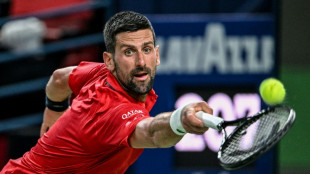 Djokovic 'hangs by rope' before battling into Shanghai last 16
Djokovic 'hangs by rope' before battling into Shanghai last 16
-
Erasmus proud of Boks' title triumph as Rugby Championship faces uncertain future
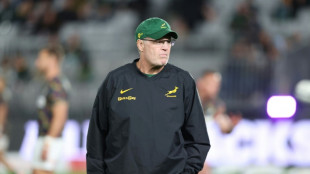
-
 French PM under pressure to put together cabinet
French PM under pressure to put together cabinet
-
US Open finalist Anisimova beats Noskova to win Beijing title

-
 Hamas calls for swift hostage-prisoner swap as talks set to begin
Hamas calls for swift hostage-prisoner swap as talks set to begin
-
Opec+ plus to raise oil production by 137,000 barrels a day in November

-
 Death toll from Indonesia school collapse rises to 45
Death toll from Indonesia school collapse rises to 45
-
Brisbane Broncos edge Storm in thrilling NRL grand final

-
 Refreshed Sabalenka 'ready to go' after post-US Open break
Refreshed Sabalenka 'ready to go' after post-US Open break
-
Georgia PM vows sweeping crackdown after 'foiled coup'

-
 Landslides and floods kill 63 in Nepal, India
Landslides and floods kill 63 in Nepal, India
-
No handshakes again as India, Pakistan meet at Women's World Cup

-
 Georgia PM announces sweeping crackdown on opposition after 'foiled coup'
Georgia PM announces sweeping crackdown on opposition after 'foiled coup'
-
Syria selects members of first post-Assad parliament

-
 Russian strikes kill five in Ukraine, cause power outages
Russian strikes kill five in Ukraine, cause power outages
-
World champion Marquez crashes out of Indonesia MotoGP

-
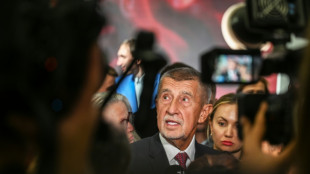 Babis to meet Czech president after party tops parliamentary vote
Babis to meet Czech president after party tops parliamentary vote
-
Death toll from Indonesia school collapse rises to 37
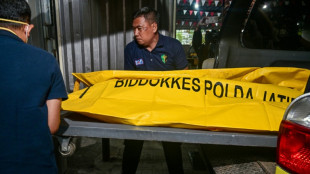
-
 OPEC+ meets with future oil production hanging in the balance
OPEC+ meets with future oil production hanging in the balance
-
Dodgers down Phillies on Hernandez homer in MLB playoff series opener

-
 Philadelphia down NYCFC to clinch MLS Supporters Shield
Philadelphia down NYCFC to clinch MLS Supporters Shield
-
Syria selects members of first post-Assad parliament in contested process

-
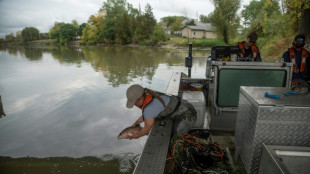 Americans, Canadians unite in battling 'eating machine' carp
Americans, Canadians unite in battling 'eating machine' carp
-
Negotiators due in Cairo for Gaza ceasefire, hostage release talks

-
 Trump authorizes troops to Chicago as judge blocks Portland deployment
Trump authorizes troops to Chicago as judge blocks Portland deployment
-
Wallabies left ruing missed chances ahead of European tour

-
 Higgo stretches PGA Tour lead in Mississippi
Higgo stretches PGA Tour lead in Mississippi
-
Blue Jays pummel Yankees 10-1 in MLB playoff series opener

-
 Georgia ruling party wins local polls as mass protests flare
Georgia ruling party wins local polls as mass protests flare
-
Depoortere stakes France claim as Bordeaux-Begles stumble past Lyon

-
 Vinicius double helps Real Madrid beat Villarreal
Vinicius double helps Real Madrid beat Villarreal
-
New museum examines family life of Mexican artist Frida Kahlo

-
 Piccioli sets new Balenciaga beat, with support from Meghan Markle
Piccioli sets new Balenciaga beat, with support from Meghan Markle
-
Lammens must be ready for 'massive' Man Utd scrutiny, says Amorim


An overview of NASA's Artemis 1 mission to the Moon
NASA's Artemis 1 mission, scheduled to take off on Monday, is a 42-day voyage beyond the far side of the Moon and back.
The meticulously choreographed uncrewed flight should yield spectacular images as well as valuable scientific data.
- Blastoff -
The giant Space Launch System rocket will make its maiden flight from Launch Complex 39B at Kennedy Space Center in Florida.
Its four RS-25 engines, with two white boosters on either side, will produce 8.8 million pounds (39 meganewtons) of thrust -- 15 percent more than the Apollo program's Saturn V rocket.
After two minutes, the thrusters will fall back into the Atlantic Ocean.
After eight minutes, the core stage, orange in color, will fall away in turn, leaving the Orion crew capsule attached to the interim cryogenic propulsion stage.
This stage will circle the Earth once, put Orion on course for the Moon, and drop away around 90 minutes after takeoff.
- Trajectory -
All that remains is Orion, which will fly astronauts in the future and is powered by a service module built by the European Space Agency.
It will take several days to reach the Moon, flying around 60 miles (100 kilometers) at closest approach.
"It's going to be spectacular. We'll be holding our breath," said mission flight director Rick LaBrode.
The capsule will fire its engines to get to a distant retrograde orbit (DRO) 40,000 miles beyond the Moon, a distance record for a spacecraft rated to carry humans.
"Distant" relates to high altitude, while "retrograde" refers to the fact Orion will go around the Moon the opposite direction to the Moon's orbit around the Earth.
DRO is a stable orbit because objects are balanced between the gravitational pulls of two large masses.
After passing by the Moon to take advantage of its gravitational assistance, Orion will begin the return journey.
- Journey home -
The mission's primary objective is to test the capsule's heat shield, the largest ever built, 16 feet (five meters) in diameter.
On its return to the Earth's atmosphere, it will have to withstand a speed of 25,000 miles per hour and a temperature of 5,000 degrees Fahrenheit (2,760 degrees Celsius).
Slowed by a series of parachutes until it is traveling at less than 20 miles per hour, Orion will splashdown off the coast of San Diego in the Pacific.
Divers will attach cables to tow it in a few hours to a US Navy ship.
- The crew -
The capsule will carry a mannequin called "Moonikin Campos," named after a legendary NASA engineer who saved Apollo 13, in the commander's seat, wearing the agency's brand new uniform.
Campos will be equipped with sensors to record acceleration and vibrations, and will also be accompanied by two other dummies: Helga and Zohar, who are made of materials designed to mimic bones and organs.
One will wear a radiation vest while the other won't, to test the impacts of the radiation in deep space.
- What will we see? -
Several on-board cameras will make it possible to follow the entire journey from multiple angles, including from the point of view of a passenger in the capsule.
Cameras at the end of the solar panels will take selfies of the craft with the Moon and Earth in the background.
- CubeSats -
Life will imitate art with a technology demonstration called Callisto, inspired by the Starship Enterprise's talking computer.
It is an improved version of Amazon's Alexa voice assistant, which will be requested from the control center to adjust the light in the capsule, or to read flight data.
The idea is to make life easier for astronauts in the future.
In addition, a payload of 10 CubeSats, shoebox-sized microsatellites, will be deployed by the rocket's upper stage.
They have numerous goals: studying an asteroid, examining the effect of radiation on living organisms, searching for water on the Moon.
These projects, carried out independently by international companies or researchers, take advantage of the rare opportunity of a launch into deep space.
F.Müller--BTB




